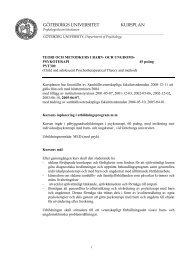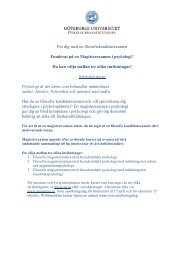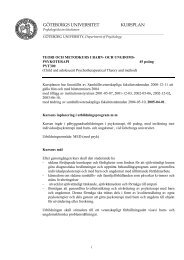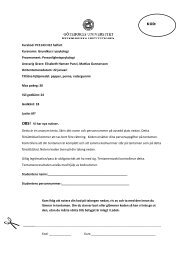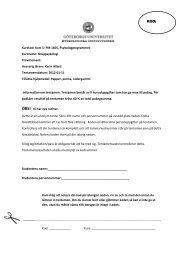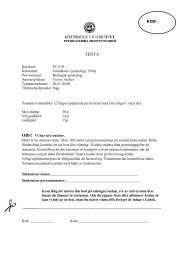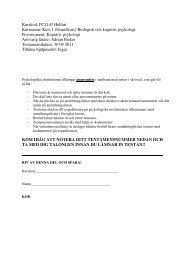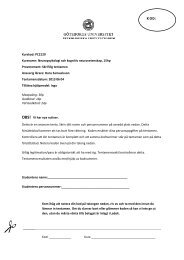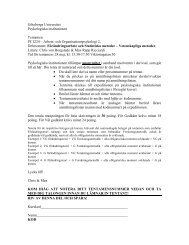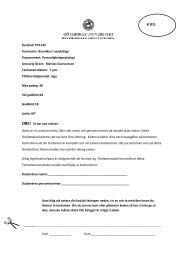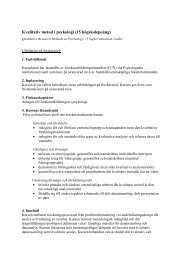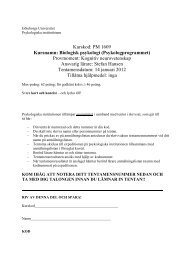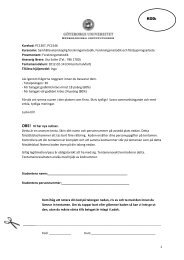Göteborg Psychological Reports University of Gothenburg
Göteborg Psychological Reports University of Gothenburg
Göteborg Psychological Reports University of Gothenburg
Create successful ePaper yourself
Turn your PDF publications into a flip-book with our unique Google optimized e-Paper software.
Göteborg<strong>Psychological</strong> <strong>Reports</strong><strong>University</strong> <strong>of</strong> <strong>Gothenburg</strong>SWEDENCecilia Jakobsson Bergstad, Amelie Gamble, OlleHagman, Lars E. Olsson, Merritt Polk &Tommy GärlingAffective-Symbolic and Instrumental-Independence<strong>Psychological</strong> Motives Mediating Effects <strong>of</strong> Socio-Demographic Variables on Daily Car Use.Number 3 Volume 39 2009
ISSN 0301-0996ISRN GU/PSYK/REP--2009/3--SE
Affective-Symbolic and Instrumental-Independence <strong>Psychological</strong> MotivesMediating Effects <strong>of</strong> Socio-Demographic Variables on Daily Car UseCecilia Jakobsson Bergstad, Amelie Gamble, Olle Hagman, Lars E. Olsson, Merritt Polk,and Tommy GärlingJakobsson Bergstad, C., Gamble, A., Hagman, O., Olsson, L. E., Polk,M., and Gärling, T. Affective-symbolic and instrumentalindependencepsychological motives mediating effects <strong>of</strong> sociodemographicvariables on daily car use. Göteborg <strong>Psychological</strong><strong>Reports</strong>, 2009, 39, No. 3. This study investigates the extent to whichaffective-symbolic and instrumental-independence psychologicalmotives mediate effects <strong>of</strong> socio-demographic variables on daily caruse in Sweden. Available national travel diary data for 16,944 carusers collected in 2005 and 2006 and questionnaire data from a mailsurvey to 1,134 car users collected in 2007 were used to assess therelationships daily car use as driver or passenger have to sex, age,household type (single or cohabiting with or without children),education, employment, income, residential area (urban, semi-rural orrural), access to cars and annual driving distance. On the basis <strong>of</strong> thequestionnaire data reliable measures <strong>of</strong> affective-symbolic andinstrumental-independence motives were constructed. The resultsshow that households with children use the car more than householdswith no children, that men make more car trips as drivers than womenwho use the car as passenger more than men, and that householdsliving in rural areas use the car more than households living in semiruralareas who use the car more than households living in urbanareas. An affective-symbolic motive partially mediates therelationship between the number <strong>of</strong> weekly car trips and sex, theinstrumental-independence motive partially mediates the relationshipsbetween weekly car use and percent car use as driver and several <strong>of</strong>the socio-demographic variables (living in urban vs. rural residentialarea for both measures; sex and living in urban vs. semi-ruralresidential area for percent car use as driver). Of several other sociodemographicvariables (age, employment, and income) affecting caruse, only the relationship <strong>of</strong> the number <strong>of</strong> cars to percent car use asdriver was (partially) mediated by the instrumental-independencemotive.Key words: Car use, socio-demographic variables, psychological motivesIn the industrialised world the private car is the primary mode <strong>of</strong> daily travel for amajority <strong>of</strong> people. This was not the case half a century ago. The forces behind increasing caruse are many. At a societal level, increasing mobility is associated with technologicaldevelopment, economic growth, and positive social change. At the individual level, thesechanges interact with psychological motives resulting in strong individual preferences for carsand car use.Lars E. Olsson is affiliated with Karlstad <strong>University</strong>, Sweden.
No.3:39, 2There is a general consensus that car use needs to be reduced in the face <strong>of</strong> negativeimpacts on the human environment (Gärling & Steg, 2007), the societal and human costs <strong>of</strong>traffic accidents (Groeger & Rothengatter, 1998), and the growing health problems caused bycar-related sedentary life styles (Dora & Phillips, 2000). Still, the car is difficult toreplacebecause <strong>of</strong> its many beneficial effects for people, such as comfort and door-to-doorflexibility. For many people driving is also in itself a positive and enjoyable activity(Gatersleben, 2007; Mokhtarian, 2005).Car use depends on access to a car and increases with the number <strong>of</strong> cars in a household(Gärling & Loukopoulos, 2007). Car use is also related to several socio-demographicvariables. It is higher among households in rural areas than among households in urban areas(Stradling, 2007), higher among households with children than households without children(Polk, 2004), and increases with income and employment (Dargay & Hanly, 2007). Menfurthermore drive more than women (Polk, 1998, 2004).Three complementary approaches explaining travel are discernible in transport research.In one approach pioneered by geographers (e.g., Hanson & Schwab, 1995), the focus is onobjective descriptions <strong>of</strong> activity/travel patterns. Structural determinants <strong>of</strong> theseactivity/travel patterns are examined, including socio-demographic variables. A secondapproach emanates from disaggregate travel-choice modeling (Ben-Akiva & Lerman, 1985;McFadden, 2001). Its goal is to understand how activity/travel patterns are determined by thetravel choices made by people in different socio-demographic strata. Consequently, it isbelieved that the effects <strong>of</strong> socio-demographic variables need an explanation. A thirdapproach (Hagman, 2003) goes further in its attempts at identifying explanations for travel. Itsgoal is to find psychological motives for the travel choices people make.In line with the last approach, the aim <strong>of</strong> the present research is to investigate whetherpsychological motives account for the effects <strong>of</strong> socio-demographic variables on daily car use.It is assumed, consistent with the second approach, that choices <strong>of</strong> car use mediate the effects<strong>of</strong> the socio-demographic variables on car use. These effects should then also be mediated bypsychological motives which determine choices <strong>of</strong> car use.Previous research has documented two types <strong>of</strong> psychological motives for car use. Onemotive is referred to as instrumental and is related to travel time, costs, physical effort, andflexibility. Another motive is referred to as affective-symbolic, focusing on the affective andsymbolic outcomes <strong>of</strong> driving, such as enjoyment, feelings <strong>of</strong> status, stress, autonomy, andsafety (Anable & Gatersleben, 2005; Jakobsson, 2007; Steg, Vlek, & Slotegraaf, 2001). Whilesome previous studies have succeeded in empirically distinguishing between these motives(e.g. Steg, 2005), other studies suggest that the affective and instrumental motives for car useare not possible to distinguish (e.g. Mann & Abraham, 2006). In a review <strong>of</strong> previousresearch, Gatersleben (2007) also posited a third motive referred to as feelings <strong>of</strong>independence found to be related to the positive experiences <strong>of</strong> using the car.In accordance with previous research on psychological motives and car use (e.g. Steg,2005), affective-symbolic motives are expected to be more influential on car use amongfrequent car drivers than instrumental and independence motives. The latter two motives mayplay a more important role for car use in rural areas and for multi-person households withchildren but a weaker role for members <strong>of</strong> younger, urban, or single households. Despite suchexpectations inferred from previous research, there is no extant theory from which explicithypotheses can be derived, except the general hypothesis that psychological motives, due totheir effects on choices <strong>of</strong> car use, mediate the relationship between car use andsociodemographic variables.The specific aim <strong>of</strong> the present study is to determine whether the psychological motivesfor car use mediate the relationships between car use and such socio-demographic variablesthat are known to affect car use. Both measures <strong>of</strong> car use and motives for car use areobtained from questions in a mail survey conducted in Sweden where car access is high
No.3:39, 3(Swedish Institute for Transport and Communications Analysis, 2007). In the Swedishpopulation 82% men and 70% women have access to one or more cars. A car is used at leastonce a week by 90% <strong>of</strong> the households, and for 64% <strong>of</strong> the total distance travelled the car isthe primary travel mode. The measures <strong>of</strong> car use obtained from questions in the mail surveyare validated by analyses <strong>of</strong> national travel diary data.MethodNational Travel SurveyIn order to determine the relationship between socio-demographic variables and car usein the Swedish population, data from the national travel surveys conducted in 2005 and 2006(Swedish Institute for Transport and Communications Analysis, 2007) were analyzed. Thesurveys consist <strong>of</strong> filled-in travel diaries for a single day. Randomly sampled respondentsbetween the ages <strong>of</strong> 6 and 84 years old received a letter describing the survey withinstructions for how to fill in the travel diary on a specified day, which was randomly selectedthroughout the year. The respondents were phoned the day after and asked questions abouttheir travel. Respondents between 6 and 17 years <strong>of</strong> age were contacted via their parents. Thesample consisted <strong>of</strong> 41,225 respondents representing a response rate <strong>of</strong> 67.6%. An analysis <strong>of</strong>dropouts revealed no sampling biases. In the present analyses 16,944 respondents with adriver’s license and a car in the household are included.Questionnaire SurveyBetween October and November 2007 a questionnaire was mailed to a sample <strong>of</strong> 3,000Swedish residents consisting <strong>of</strong> approximately 1,000 randomly selected from each <strong>of</strong>metropolitan areas with more than 200,000 residents, semi-rural areas with between 20,000and 200,000 residents, and rural areas with less than 20,000 residents. A total <strong>of</strong> 1,332 usablequestionnaires were obtained (representing a response rate <strong>of</strong> 44.4%). Respondents wereselected for the analyses if they stated in the questionnaire that they have a driving license andaccess to a car. This resulted in a sample <strong>of</strong> 1,134 respondents. A description <strong>of</strong> the sample isgiven in Table 1.The questionnaire was sent by regular mail including a free-<strong>of</strong>-charge return envelope.It took about 15 minutes to answer. The respondents were <strong>of</strong>fered the possibility to obtain twolottery tickets in compensation for their participation. A combined thank-you and remindercard was sent after approximately one week giving respondents the option to answer thequestionnaire via the web. About 5% <strong>of</strong> the usable questionnaires were obtained in this way.Several modules were included in the questionnaire covering also issues that will bereported elsewhere (Jakobsson Bergstad et al., 2009a, 2009b). The modules providing the datafor the present analyses consisted <strong>of</strong> (1) answers to 32 statements related to the, affectivesymbolic,instrumental, and independence psychological motives for car use (adapted fromSteg, 2005, see Table 2) obtained on seven-point rating scales ranging from “totally disagree”(0) to “agree completely” (6), (2) questions about the frequency <strong>of</strong> performance <strong>of</strong> dailyactivities 1 and whether a car was used as a driver or passenger to travel to these activities 2 ,and (3) questions about socio-demographic factors including sex, age, cohabiting status,presence <strong>of</strong> children, education, employment, income, number <strong>of</strong> cars, and annual drivingdistance.1 These included the most frequently reported out-<strong>of</strong>-home activities in the Swedish national travel surveysincluding work or study; purchases <strong>of</strong> non-durables; other purchases; participating in sports, exercise oroutdoor activities; participating in out-<strong>of</strong>-home hobbies, religious, course or club activities; visiting relativesand friends; visiting restaurants, cafés or entertainment/cultural events; picking up or leaving children at schoolor day care centre, and; participating in children’s leisure activities.2 For each activity respondents reported how many times during the previous week (never, one, two, three, four,five, or more than five times) they had travelled by car (as driver or passenger) or used any other travel modewith the purpose <strong>of</strong> performing the activity.
No.3:39, 4Table 1. Sample descriptives (total sample size = 1134).Variable Sample size DescriptiveSex (% women) 1134 53.7Age (years) (M/SD) 1127 46.3/12.4Household type (%) 1128 99.5Single households with no children 143 12.7Single households with children 57 5.1Cohabiting households no children 387 34.3Cohabiting households with children 486 43.1Other 55 4.9<strong>University</strong> education (%) 396 35.2Full-time employment (%) 631 56.3Percent employment (M/SD) 1120 69.8/42.8Annual household gross income, in ’000 SEK* (%)600Residential area (%)Rural (200 000 inhabitants)109798204203224171197109248746514096.78.918.618.520.415.618.096.344.642.612.8Number <strong>of</strong> cars in household (M/SD) 1119 1.6/0.7Estimated annual driving distance in km (M/SD) 1042 15,865/16,0261 SEK is approximately equal to 0.10 EuroResultsTravel Diary DataTable 2 shows that households with children make more car trips and travel by car longerdistances than households with no children. Table 3 indicates that men make more car tripsand drive longer distances than women, whereas women use the car as passenger more thanmen. As may be seen in Table 4, car use is larger in rural than in semi-rural residential areas,and larger in semi-rural than in urban residential areas.Table 2. Mean number <strong>of</strong> daily car trips and mean daily car use in km as driver and passengerrelated to household type. (Respondents with a driver’s license and with one or more cars inthe household).SinglewithoutchildrenN= 2527Single withchildrenn= 637Cohabitingwithoutchildrenn= 7614Cohabitingwith childrenn= 5693# daily car trips 1.9 2.7 1.9 2.4Km car use as driver 28.4 33.1 27.3 33.3Km car use as passenger 4.4 4.0 8.7 7.6
No.3:39, 5Table 3. Mean number <strong>of</strong> daily car trips and mean daily car use in km as driver and passengerrelated to sex. (Respondents with a driver’s license and with one or more cars in thehousehold).MenN = 9066Womenn= 7878# daily car trips 2.2 2.1Km car use as driver 37.5 20. 6Km car use as passenger 4.0 11.4Table 4. Mean number <strong>of</strong> daily car trips and mean daily car use in km as driver and passengerrelated to residential area. (Respondents with a driver’s license and with one or more cars inthe household).Urbann = 2019Semi-ruraln = 4680Ruraln = 589# daily car trips 1.7 2.2 2.0Km car use as driver 21.7 29.5 39.0Km car use as passenger 5.6 8.2 9.2Questionnaire DataTable 5 displays means, standard deviations, skewness, and intercorrelations <strong>of</strong> theratings <strong>of</strong> the motives. The conditions for performing a principal component analysis (PCA)were met in that some correlations were larger than .30, the Kaiser-Meyer-Oklin measureexceeded .60, and the Bartlett’s test <strong>of</strong> sphericity was statistically significant (p < .001) (HairAnderson, Tatham, & Black, 2006). Two components were extracted in the PCA andsubmitted to an oblique (oblimin) rotation. The two components accounted for 41.5% <strong>of</strong> thetotal variance. After removing 7 items with component loadings less than .30 orcommunalities less than .50, an additional PCA extracted two components explaining 46.8 %<strong>of</strong> the variance. The component loadings after rotation are given in Table 6. As may be seen,the first component loads on affective-symbolic motives, whereas the second componentloads on both instrumental and independence motives for car use. A reliable scale <strong>of</strong>affective-symbolic motives were constructed by averaging across the ratings with highloadings (≥ .54, boldface in the table) only on the first component (Cronbach´s α = .91), and areliable scale <strong>of</strong> instrumental-independence motives were constructed by averaging across theratings with high loadings (≥ .51, boldface in the table) only on the second component(Cronbach´s α = .87).In order to determine the effects <strong>of</strong> the socio-demographic variables on the measures <strong>of</strong>the affective-symbolic and the instrumental-independence motives, two OLS multiple linearregression analyses were performed (see Table 7). The independent variables were sex, age(36-54 years vs 18-35 years and 55+ years vs. 18-35 years), having children or not, cohabitingor not, education (university degree vs. no university degree), employment (percent <strong>of</strong> fulltime),income (coded 1-6), residential area (rural vs. urban and semirural vs. urban) andnumber <strong>of</strong> cars. In each analysis the motive not used as a dependent variable was entered asan independent variable in order to control for its influence on the other independentvariables. Table 4 shows that several <strong>of</strong> the independent variables had a significant effect onboth the symbolic-affective and instrumental-independence motives, accounting for 22% and19% <strong>of</strong> the variance, respectively.A set <strong>of</strong> OLS multiple linear regression analyses was performed to determine the extentto which the affective-symbolic and instrumental-independence motives mediate the effects <strong>of</strong>the socio-demographic variables on daily car use. Three different measures <strong>of</strong> daily car usewere used as dependent variables: (1) Number <strong>of</strong> car trips to the activities during previousweek; (2) Percent car use as driver to the activities during previous week, and; (3) Percent car
Table 5. Means (M), standard deviations (SD), skewness (Skew) and inter-correlations <strong>of</strong> ratings <strong>of</strong> motives for car use (n = 1134)Statement M SD Skew 1 2 3 4 5 6 7 8 9 10 11 12 13 14 151. Express myself through my car 1.1 1.6 1.272. My car suits me 4.0 1.8 -.75 .283. The car brings me wherever I want 5.5 1.0 -2.37 .09 .224. Driving saves a lot <strong>of</strong> time 5.1 1.3 -1.50 .10 .19 .415. Driving is sporty and adventurous 1.5 1.6 0.93 .57 .23 .14 .166. Driving is my hobby 0.9 1.5 1.64 .48 .17 .09 .09 .617. My car has a nice road-holding 4.4 1.7 -1.10 .12 .31 .19 .09 .11 .488. The car gives me power in traffic 1.0 1.5 1.55 .44 .17 .06 .10 .45 .40 -.089. Driving makes my life more easy 5.0 1.4 -1.49 .09 .17 .41 .48 .15 .11 .09 .0810. I can visit friends, family 5.3 1.1 -2.01 .05 .24 .45 .37 .11 .12 .19 .01 4611. Feelings <strong>of</strong> freedom 4.6 1.5 -1.14 .20 .26 .39 .34 .30 .24 .20 .16 .43 .4012. Provides privacy 2.5 1.9 0.21 .43 .23 .20 .21 .46 .38 .11 .38 .26 .21 .4513. Protection against bad weather 4.6 1.7 -1.13 .14 .21 .23 .28 .25 .19 .11 .15 .29 .27 .33 .3314. Driving is comfortable 5.0 1.2 -1.25 .14 .23 .32 .39 .24 .19 .20 .12 .43 .36 .44 .33 .5315. I enjoy driving a nice, good-looking car 3.4 2.0 -0.32 .40 .25 .19 .21 .51 .37 .12 .34 .25 .17 .35 .43 .34 .3816. The car is always available 4.8 1.6 -1.35 .11 .24 .28 .24 .13 .12 .16 .03 .30 .28 .27 .20 .21 .27 .1717. I am free to stop everywhere 5.0 1.4 -1.68 .10 .22 .35 .30 .17 .15 .19 .06 .34 .38 .41 .24 .25 .41 .1918. I am safe in my car 3.9 1.6 -0.48 .20 .27 .26 .21 .26 .24 .30 .23 .21 .25 .33 .33 .26 .32 .3219. I can distinguish myself from others 1.7 1.7 0.75 .46 .20 .12 .12 .49 .42 .02 .44 .11 .08 .23 .45 .27 .20 .4020. I get a kick out <strong>of</strong> driving 1.3 1.7 1.20 .51 .15 .11 .09 .64 .60 .06 .44 .15 .10 .30 .45 .23 .25 .4621. I am not dependent on others 4.6 2.5 12.59 .09 .22 .33 .28 .13 .12 .20 .06 .33 .30 .37 .23 .34 .37 .1822. I can go out 4.7 1.6 -1.18 .08 .27 .34 .29 .15 .16 .20 .08 .35 .44 .43 .27 .34 .40 .2323. I am a bit in love with my car 1.6 1.9 0.94 .40 .31 .11 .11 .43 .40 .09 .36 .10 .09 .28 .40 .21 .23 .3724. Driving is enjoyable 2.8 1.9 0.07 .33 .29 .21 .13 .47 .45 .27 .21 .18 .20 .41 .41 .29 .37 .4325. I can chose my own route 5.0 1.4 -1.56 .10 .26 .35 .26 .20 .18 .22 .09 .33 .37 .37 .22 .31 ..40 .2326. The car gives me prestige 1.4 1.6 0.93 .56 .25 .12 .12 .57 .47 .11 .49 .11 .11 .26 .48 .26 .23 .4727. Its carrying capacity (luggage, purchases) 5.0 1.3 -1.53 -.01 .19 .26 .22 .05 .05 .19 .03 .28 .27 .22 .10 .25 .27 .1528. Enables recreational trips and holidays 5.0 1.5 -1.47 .11 .23 .25 .21 .16 .11 .23 .09 .22 .32 .31 .22 .30 .31 .2329. I can pick up and see <strong>of</strong>f others 4.6 1.6 -1.08 .09 .18 .24 .22 .19 .13 .14 .11 .26 .34 .29 .21 .27 .32 .2430. Driving is relaxing 3.1 1.8 -0.17 .31 .22 .18 .18 .44 .41 .11 .26 .20 .26 .39 .41 .27 .37 .4031. I love driving fast 2.4 1.9 0.29 .35 .14 .14 .15 .50 .37 .06 .30 .16 .10 .27 .36 .19 .25 .4932 I love the drone <strong>of</strong> my engine and muffler 1.1 1.6 1.38 .41 .14 .08* .10 .54 .50 .06 .31 .10 .08 .22 .32 .20 .18 .38
Table 5 (continued)Statement 16 17 18 19 20 21 22 23 24 25 26 27 28 29 30 3117. I am free to stop everywhere .5318. I am safe in my car .26 .3319. I can distinguish myself from others .13 .17 .3220. I get a kick out <strong>of</strong> driving .09 .15 .26 .5721. I am not dependent on others .38 .46 .26 .17 .1422. I can go out .37. .44 .30 .23 .20 .5523. I am a bit in love with my car .13 .20 .27 .41 .50 .19 .2724. Driving is enjoyable .21 .28 .30 .33 .53 .26 .33 .5025. I can chose my own route .37 .53 .30 .16 .17 .47 .45 .21 .3526. The car gives me prestige .09 .12 .28 .56 .59 .13 .20 .52 .44 .1727. Its carrying capacity (luggage, purchases) .15 .21 .22 .09 .04 .21 .28 .02 .13 .28 .0828. Enables recreational trips and holidays .22 .29 .32 .18 .12 .26 .42 .16 .23 .33 .19 .4029. I can pick up and see <strong>of</strong>f others .16 .26 .30 .20 .14 .23 .35 .14 .23 .33 .18 .38 .5330. Driving is relaxing .18 .24 .35 .35 .45 .19 .32 .42 .62 .28 .41 .13 .29 .3131. I love driving fast .13 .18 .27 .35 .50 .15 .15 .30 .40 .20 .40 .07 .13 .18 .4332 I love the drone <strong>of</strong> my engine and muffler .10 .14 .20 .42 .55 .10 .12 .36 .39 .17 .45 .02 .08 .14 .37 .55Note. Statements are shown in the order they were presented in the questionnaire.
8Table 6. Obliquely (oblimin) rotated principal-component loadings <strong>of</strong> ratings <strong>of</strong> affectivesymbolicand instrumental-independence psychological motives for car use.Component 1Affective-symbolicComponent 2Instrumental-independenceI get a kick out <strong>of</strong> driving .83 -.05Driving is sporty and adventurous .81 -.03The car gives me prestige .79 -.04Driving is my hobby .74 -.05Express myself through my car .74 -.12I love the drone <strong>of</strong> my engine and muffler .71 -.07I can distinguish myself from others .70 -.01The car gives me power in traffic .65 -.13I enjoy driving a nice, good-looking car .59 .18I love driving fast .62 .06I am a bit in love with my car .63 .06Driving is enjoyable .57 .26Provides privacy .57 .22Driving is relaxing .54 .25I can visit family and friends -.11 .71I can go out .03 .71I am free to stop everywhere -.01 .68I can chose my own route .04 .67Driving makes my life more easy -.04 .67I am not dependent on others -.02 .66The car brings me wherever I want -.06 .65Driving is comfortable .13 .63Feelings <strong>of</strong> freedom the car gives me .20 .61Driving saves a lot <strong>of</strong> time -.03 .60Enables recreational trips and holidays .05 .51Table 7. OLS multiple linear regression analyses with the dependent variables affective-symbolic motive andinstrumental-independence motive.Affective-symbolic motives Instrumental-independence motivesn β t p n β t pAffective-symbolic motive 1126 0.41 13.99
Table 11. OLS multiple linear regression analyses with the dependent variables number <strong>of</strong> weekly car trips, percent car use as driver, and percent car use as passenger and sociodemographicvariables entered in the first step and the affective-symbolic and the instrumental-independent motives entered in the second step as the independent variables.Number <strong>of</strong> weekly car trips Percent car trips as driver Percent car trips as passengerStep 1 n β t P n β t p n β t pSex (man 1, woman -1) 1129 0.09 2.97 .003 1129 0.19 6.18
In the second step the measures <strong>of</strong> affective-symbolic and instrumental-independencemotives were entered. Significant increases in accounted variance (2%, 3%, and 1%respectively) are observed. The regression coefficients for the instrumental-independencemotives are significant on the dependent variables number <strong>of</strong> weekly car trips and percent caras driver, and close to significant for the dependent variable percent car as passenger (p =.051). The regression coefficients for affective-symbolic motives are only significant on thenumber <strong>of</strong> weekly car trips. Sobel tests showed that the affective-symbolic motives partiallymediated the relationship between the number <strong>of</strong> weekly car trips and sex (z = 2.08, p = .038),that the instrumental-independence motives partially mediated the relationship between thenumber <strong>of</strong> weekly car trips and living in urban vs. rural residential areas (z = 2.06, p = .039),and that the instrumental-independence motives partially mediated the relationships betweenthe percent car use as driver and the socio-demographic variables sex (z = 2.45, p = .014),urban vs. rural residential area (z = 2.40, p = .016), urban vs. semi-rural residential area (z =2.08, p = .037), and the number <strong>of</strong> cars in household (z = 2.03, p = .042).DiscussionThe present study set out to investigate whether the effects <strong>of</strong> socio-demographicvariables on daily car use in Sweden are mediated by affective-symbolic and instrumentalindependencepsychological motives. It is concluded, firstly, that there were differences indaily car use between men and women, between households with and without children, andamong households living in urban, rural, and semi-rural areas. Secondly, from 7% to 15% <strong>of</strong>the variance in weekly car use in travel related to frequently performed activities wasaccounted for by the socio-demographic variables (including also age, university education,percent employment, income, and number <strong>of</strong> cars). Thirdly, it was possible to constructreliable questionnaire measures <strong>of</strong> affective-symbolic and instrumental-independencepsychological motives for car use.In accordance with the main aim <strong>of</strong> the present research, evidence was found that thepsychological motives mediate and thus explain some <strong>of</strong> the differences in car use betweendifferent socio-demographic groups. The implication is that the psychological motives areproximal determinants <strong>of</strong> choices <strong>of</strong> car use. However, primarily the instrumentalindependencepsychological motive mediated the relationships between daily car use and thesocio-demographic variables, and apart from the effect <strong>of</strong> sex which was partially mediated byboth psychological motives (implying that men drive more than women both due to affectivesymbolicand instrumental-independence motives), the mediated socio-demographic variableswere restricted to residential area and the number <strong>of</strong> cars in the household. The partialmediation as well as failures <strong>of</strong> mediation implies that there are also direct effects <strong>of</strong>sociodemographic variables on daily car use. Yet, for this reason the results do not excludeother individual-level explanatory factors, not measured in the present study.A full mediation <strong>of</strong> residential area may require a more refined categorization than inurban, semi-rural, and rural. Within each <strong>of</strong> these types <strong>of</strong> areas, residential location is likelyto vary substantially with respect to accessibility to different activity nodes. Even thoughpartial mediation was found at the chosen aggregation level, it may change to full mediation ata more disaggregate level. Furthermore, the number <strong>of</strong> cars available to the household, thatwill increase accessibility to activity nodes, in part should have reduced the mediation <strong>of</strong> theinstrumental-independence motive. At the same time, the mediation <strong>of</strong> the number <strong>of</strong> carssuggests that the versatility <strong>of</strong> the car is a similar benefit to all households, something thatwould otherwise not be revealed in analyses <strong>of</strong> individual differences.An issue that needs to be addressed further is why the affective-symbolic motive wasrated to have little impact and only mediated the effect on daily car use <strong>of</strong> sex, not the othersociodemographic variables. One possible reason, pointed out by Steg et al. (2001), is thatmeasures <strong>of</strong> affective-symbolic motives are influenced by social desirability. It is not sociallydesirable to express a positive affect for owning and driving a car and that owning a car is an
important status marker. Therefore, some indirect method is needed to assess its effect.Another perhaps more plausible reason, supported by the present mediation analyses, is thatthe instrumental-independence motive pertains to those segments <strong>of</strong> the population (peopleliving in semi-rural and rural areas) dominating the sample. An affective-symbolic motivemay be more important for urban-living, car-owning male and female singles withoutchildren. In addition, car use was measured for travel to frequently performed out-<strong>of</strong>-homeactivities, many <strong>of</strong> which are instrumental.Some previous studies have distinguished between affective-symbolic and instrumentalpsychological motives for car use (e.g. Steg et al. 2001), whereas other studies haveconcluded that it is not possible to identify different motives (e.g. Mann & Abraham, 2006).Still others (e.g. Steg, 2005; Gatersleben, 2007) have suggested the existence <strong>of</strong> more thantwo motives. The present study including a large number <strong>of</strong> statements covering the motivesfor car use, administered in a survey to a large population-based sample, revealed two distinct,correlated motives which were identified as affective-symbolic and instrumental-independencemotives. Reliable scales measuring these motives were possible to construct. The presentresearch thus takes a further step towards clarifying the motive structure <strong>of</strong> private car use, aswell as to provide a measuring instrument that can be used in future research for assessingthese motives. If required, additional refinements may be possible by distinguishing theaffective, symbolic, instrumental, and independence components.AcknowledgementsFinancial support for this research was obtained by grant #AL90A 2006:16305 from theSwedish Road Administration through the program “Social and economic impacts <strong>of</strong> theautomobile“ (www.BISEK.se) to the Centre for Consumer Science, School <strong>of</strong> Business,Economics, and Law, <strong>University</strong> <strong>of</strong> <strong>Gothenburg</strong>, Sweden.ReferencesAnable, J., & Gatersleben, B. (2005). All work and no play? The role <strong>of</strong> instrumental andaffective factors in work and leisure journeys by different travel modes. TransportationResearch A, 39, 163-181.Ben-Akiva, M., & Lerman, S. (1985). Discrete choice analysis: Theory and applications.Cambridge, MA: MIT Press.Dargay, J., & Hanly, M. (2007). Volatility <strong>of</strong> car ownership, commuting mode and time in theUK. Transportation Research A, 41, 934-948.Dora, C., & Phillips, M. A. (2000). Transport, environment, and health (no. 89). Copenhagen:World Health Organization Regional Office for Europe.Gatersleben, B. (2007). Affective and symbolic aspects <strong>of</strong> car use. In T. Gärling & L. Steg(Eds.), Threats from car traffic to the quality <strong>of</strong> urban life (pp. 219-233). Amsterdam:Elsevier.Gärling, T., & Loukopoulos, P. (2007). Economic and psychological determinants <strong>of</strong> carownership and use. In A. Lewis (Ed.), Cambridge handbook <strong>of</strong> psychology and economicbehaviour (pp. 383-405). Cambridge: Cambridge <strong>University</strong> Press.Gärling, T., & Steg, L. (Eds.) (2007). Threats from car traffic to the quality <strong>of</strong> urban life :problems, causes, and solutions. Amsterdam ; Oxford: Elsevier.Groeger, J. A., & Rothengatter, J. A. (1998). Traffic psychology and behaviour. TransportPsychology F, 5, 235-248.Hair, J. F., Anderson, R. F., Tatham, R. L., & Black, W. C. (2006). Multivariate data analysis(6th ed.). HillsdaleHagman, O. (2003). Mobilizing meanings <strong>of</strong> mobility: Car user's constructions <strong>of</strong> the goodsand bads <strong>of</strong> car use. Transportation Research D, 8, 1-9.
Hanson, S., & Schwab, M. (1995). Describing disaggregate flows: Individual and householdactivity patterns. In S. Hanson (Ed.), The geography <strong>of</strong> urban transportation (pp. 166-187). New York: Guilford Press.Jakobsson, C. (2007). Instrumental motives for private car use. In T. Gärling & L. Steg(Eds.), Threats to the quality <strong>of</strong> urban life from car traffic: Problems causes, and solutions(pp. 205-217). Amsterdam: Elsevier.Jakobsson Bergstad, C., Gamble, A., Hagman, O., Polk, M., Gärling, T., Ettema, D., Friman,M., & Olsson, L. E. (2009a). Impacts <strong>of</strong> routine out-<strong>of</strong>-home activities on subjective wellbeing(Göteborg <strong>Psychological</strong> <strong>Reports</strong> No. 39:4). Göteborg, Sweden: Department <strong>of</strong>Psychology, <strong>University</strong> <strong>of</strong> <strong>Gothenburg</strong>.Jakobsson Bergstad, C., Gamble, A., Hagman, O., Polk, M., Gärling, T., Ettema, D., Friman,M., & Olsson, L. E. (2009b). Subjective well-being related to satisfaction with daily travel(Göteborg <strong>Psychological</strong> <strong>Reports</strong> No. 39:5). Göteborg, Sweden: Department <strong>of</strong>Psychology, <strong>University</strong> <strong>of</strong> <strong>Gothenburg</strong>.Mann, E., & Abraham, C. (2006). The role <strong>of</strong> affect in UK commuters’ travel mode choice,British Journal <strong>of</strong> Psychology, 97, 155-176.McFadden, D. (2001). Disaggregate behavioral travel demand´s RUM side: A 30-yearretrospective. In D. Hensher (Ed.), Travel behavior research: The leading edge (pp. 17-63). Amsterdam: Elsevier.Mokhtarian, P. L. (2005). Travel as a desired end, not just a means. Transportation ResearchA, 39, 93-96.Polk, M. (1998) Gendered mobility: Women's and men's relations to automobility in Sweden.Ph.D. dissertation. Göteborg, Sweden: <strong>University</strong> <strong>of</strong> <strong>Gothenburg</strong>, Center forInterdisciplinary Studies.Polk, M. (2004). The influence <strong>of</strong> gender on daily car use and on willingness to reduce car usein Sweden. Journal <strong>of</strong> Transport Geography, 12, 185-195.Swedish Institute for Transport and Communications Analysis (2007). RES 2005-2006 : dennationella resvaneundersökningen. Stockholm: Swedish Institute for Transport andCommunications Analysis.Steg, L., Vlek, C., & Slotegraaf, G. (2001). Instrumental-reasoned and affective-symbolicmotives for using a motor car. Transportation Research F, 4, 151-169.Steg, L. (2005). Car use: lust and must. Instrumental, symbolic and affective motives for caruse. Transportation Research A, 39, 147-162.Stradling, S. G. (2007). Determinants <strong>of</strong> car dependence. In T. Gärling & L. Steg (Eds.),Threats from car traffic to the quality <strong>of</strong> urban life (pp. 187-204). Amsterdam: Elsevier.



